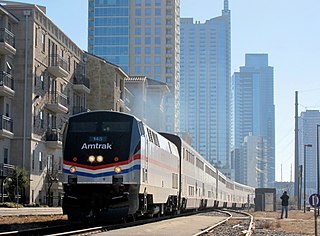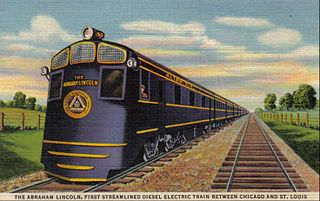
The City of New Orleans is a long-distance passenger train operated by Amtrak on an overnight schedule between Chicago and New Orleans. The train is a successor to the Illinois Central Railroad's Panama Limited.

The Texas Eagle is a long-distance passenger train operated daily by Amtrak on a 1,306-mile (2,102 km) route between Chicago, Illinois, and San Antonio, Texas, with major stops in St. Louis, Little Rock, Dallas, Fort Worth, and Austin. Three days per week, the train joins the Sunset Limited in San Antonio and continues to Los Angeles via El Paso and Tucson. The combined 2,728-mile (4,390 km) route is the longest in the United States and the second-longest in the Americas, after the Canadian.

The Missouri Pacific Railroad, commonly abbreviated as MoPac, was one of the first railroads in the United States west of the Mississippi River. MoPac was a Class I railroad growing from dozens of predecessors and mergers. In 1967, the railroad operated 9,041 miles of road and 13,318 miles of track, not including DK&S, NO&LC, T&P, and its subsidiaries C&EI and Missouri-Illinois.

The Illinois Zephyr and Carl Sandburg are a pair of passenger trains operated by Amtrak on a 258-mile (415 km) route between Chicago and Quincy, Illinois. As Illinois Service trains, they are partially funded by the Illinois Department of Transportation. Between Chicago and Galesburg, Illinois, the trains share their route with the California Zephyr and Southwest Chief; the remainder of the route (Galesburg–Quincy) is served exclusively by the Illinois Zephyr/Carl Sandburg.

The Lincoln Service is a 284-mile (457 km) higher-speed rail service operated by Amtrak that runs between Chicago, Illinois and St. Louis, Missouri. The train is a part of the Illinois Service and is partially funded by the Illinois Department of Transportation. The train uses the same route as the long-distance Texas Eagle, which continues to San Antonio and Los Angeles. A connection with the Kansas City-bound Missouri River Runner is available in St. Louis.

Michigan Services are three Amtrak passenger rail routes connecting Chicago, Illinois with the Michigan cities of Grand Rapids, Port Huron, and Detroit, and stations en route. The group falls under the Amtrak Midwest brand and is a component of the Midwest Regional Rail Initiative.

The Gulf, Mobile and Ohio was a Class I railroad in the central United States whose primary routes extended from Mobile, Alabama, and New Orleans, Louisiana, to St. Louis and Kansas City, Missouri, as well as Chicago, Illinois.

The Kansas City Mule and St. Louis Mule were a pair of 283-mile (455 km) passenger trains operated by Amtrak running between St. Louis and Kansas City, Missouri as part of the Missouri Service train network. Also operating over this route was the Ann Rutledge, which originated in Chicago. In January 2009, Amtrak consolidated these trains under the name Missouri River Runner.

The Alton Railroad was the final name of a railroad linking Chicago to Alton, Illinois; St. Louis, Missouri; and Kansas City, Missouri. Its predecessor, the Chicago and Alton Railroad, was purchased by the Baltimore and Ohio Railroad in 1931 and was controlled until 1942 when the Alton was released to the courts. On May 31, 1947, the Alton Railroad was merged into the Gulf, Mobile and Ohio Railroad. Jacob Bunn had been one of the founding reorganizers of the Chicago & Alton Railroad Company during the 1860s.

Forgottonia, also spelled Forgotonia, is the name given to a 16-county region in Western Illinois in the late 1960s and early 1970s. This geographic region forms the distinctive western bulge of Illinois that is roughly equivalent to "The Tract", the Illinois portion of the Military Tract of 1812, along and west of the Fourth Principal Meridian. Since this wedge-shaped region lies between the Illinois and Mississippi rivers, it has historically been isolated from the eastern portion of Central Illinois.

Springfield station is a brick railroad depot in Springfield, Illinois, the state capital. It is at mile 185 on Amtrak's Illinois and Missouri Route. As of 2007, it is served by five daily round trips each way: the daily Texas Eagle, and four daily Lincoln Service frequencies. It will be replaced by the Springfield-Sangamon Transportation Center, which is currently under construction, and expected to open in 2025.

The State House was a passenger train operated by Amtrak between Chicago, Illinois, and St. Louis, Missouri in the United States. This service began in 1973 and continued until 2006, when it was re-branded as the Lincoln Service as part of a three-fold service expansion over that route.

Alton Regional Multimodal Transportation Center, also known as Alton station, is a station in Alton, Illinois, that is served by Amtrak's Lincoln Service and the Texas Eagle. This was also a stop for the Ann Rutledge until April 2007. It is one of three Amtrak stations in the St. Louis metropolitan area; the other two are the Gateway Multimodal Transportation Center located in downtown St. Louis, and the Amtrak station in Kirkwood, Missouri.

Springfield Union Station in Springfield, Illinois, is a former train station and now part of the complex of buildings that together form the Abraham Lincoln Presidential Library and Museum. It is listed on the National Register of Historic Places, and is located at 500 East Madison Street in downtown Springfield, adjacent to the Lincoln Presidential Library.

Pontiac station is an Amtrak train station in Pontiac, Livingston County, Illinois, United States. Pontiac station is served by the Illinois-focused Lincoln Service between Chicago Union Station and the Gateway Transportation Center in St. Louis, Missouri and the long-distance Texas Eagle between Chicago and Los Angeles Union Station. Until April 2007, Pontiac was also served by the Ann Rutledge, a train from Chicago to Kansas City Union Station. Pontiac station boasts a single, low-level side platform for trains, along with a station depot for passengers. The station also has a wheelchair lift and handicap-accessibility per the Americans with Disabilities Act of 1990.

The Abraham Lincoln was a named passenger train operated by the Baltimore and Ohio Railroad from 1935 into the 1960s. The Abe Lincoln ran between Chicago and St. Louis on the B&O's subsidiary Alton Railroad. The train later passed to the Gulf, Mobile and Ohio Railroad, and then finally to Amtrak, which retained the name until 1978. Service between Chicago and St. Louis is now known by the umbrella term Lincoln Service. This train was the first streamlined passenger service to travel the 284 miles between Chicago and St. Louis, with Joliet, Bloomington-Normal, Springfield and Alton in between. Passengers can get a glimpse of the Mississippi River between Alton and St. Louis.

The Missouri River Runner is a 283-mile (455 km) passenger train service operated by Amtrak in Missouri between Gateway Transportation Center in St. Louis and Union Station in Kansas City. The eastern half of the route runs largely along the right bank of the Missouri River.

The Prairie Marksman was a daily passenger train operated by Amtrak between Chicago's Union Station and East Peoria, Illinois. The route was an indirect successor to the Rock Island's Peoria Rocket.

The National Limited was a passenger train that ran between Kansas City, Missouri, and both New York City and Washington, D.C., splitting in Pennsylvania. Amtrak operated the train from 1971 to 1979.

The Alton Limited was the Chicago & Alton Railway's (C&A) flagship service between Chicago, Illinois. and St. Louis, Missouri. It was introduced in 1899 and re-equipped in 1905 and 1924. The name and service were discontinued in late 1971.





















